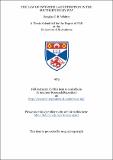Files in this item
The law of interstellar extinction in the southern Milky Way
Item metadata
| dc.contributor.advisor | van Breda, I. G. | |
| dc.contributor.author | Whittet, D. C. B. (Doug C. B.) | |
| dc.coverage.spatial | 255 p. | en_US |
| dc.date.accessioned | 2018-06-20T15:49:28Z | |
| dc.date.available | 2018-06-20T15:49:28Z | |
| dc.date.issued | 1975 | |
| dc.identifier.uri | https://hdl.handle.net/10023/14363 | |
| dc.description.abstract | Photoelectric scanner observations are combined with infrared photometry in the JHKL bands to give interstellar extinction curves by the colour difference method for 25 reddened stars in the Southern Milky Way. The observed stars are distributed from galactic longitude 𝓁 ᴵᴵ= 260°; through the Galactic Centre to 𝓁 ᴵᴵ= 30°. The scanner data ranges in wavelength from 3A80 to 5240 A with a resolution of 40 A in the second order of diffraction, and from 5080 to 8040 A with a resolution of 80 A in the first order. The infrared photometry extends the wavelength coverage to 3.5 µ. The normalized extinction curves show appreciable variations from star to star which are not apparently related to galactic structure. In several cases stars quite close together in the sky show appreciably different curves, suggesting that fluctuations in the grain size distribution may be occurring on a fairly localized scale. Using a graphite-iron-silicate grain model, extinction curves computed from the Mie theory are fitted to the observational data. This provides a theoretical basis for extrapolation of the curves to 𝜆 ⁻¹=0, allowing the ratio of total to selective extinction, R, to be deduced. R varies between 2.6 and 3.5 for 22 stars lying within 10° of the galactic plane, and between 3.8 and 4.3 for 3 stars in Upper Scorpius. One of the Upper Scorpius stars studied, HD 147889, lies in an HII region near the centre of the p Oph complex of dust and nebulosity, A variable extinction analysis applied to members of the Sco OB-2 association indicates an increase in the value of R for stars lying towards nebulosity in the complex; for these stars alone a result of R = 4.2 ± 0.5 is derived, whilst for the remainder, R = 3.3 ± 0.3. The distance modulus of the association is deduced to be 6.1 ± 0.1, which is in good agreement with the kinematical value. The scanner extinction curves contain considerable broadband structure. In particular, a depressed region between wavenumbers 1.6 and 1.97 µ⁻¹ is a common feature of the curves. A similar depression was noted by Whiteoak in the extinction curves of Northern Milky Way stars. Its depth correlates well with reddening, suggesting that the feature originates in the grains. The extinction curve of HD 147889 shows a -1 cusp-like depression at 1.97 µ⁻¹ which divides the curve into two distinct sections. The ratio of the 4430 A diffuse interstellar band height to colour excess shows signs of systematic variation with longitude for stars whose reddening occurs mainly in the local spiral arm. | en_US |
| dc.language.iso | en | en_US |
| dc.publisher | University of St Andrews | |
| dc.subject.lcc | QB819.W5 | |
| dc.subject.lcsh | Milky Way | en |
| dc.title | The law of interstellar extinction in the southern Milky Way | en_US |
| dc.type | Thesis | en_US |
| dc.type.qualificationlevel | Doctoral | en_US |
| dc.type.qualificationname | PhD Doctor of Philosophy | en_US |
| dc.publisher.institution | The University of St Andrews | en_US |
This item appears in the following Collection(s)
Items in the St Andrews Research Repository are protected by copyright, with all rights reserved, unless otherwise indicated.

